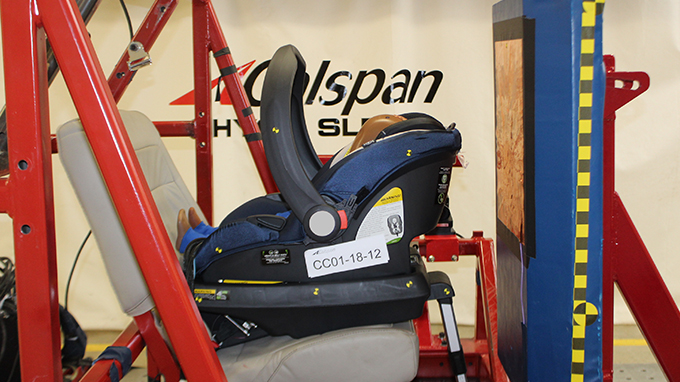Research In Action
Research In Action
Breadcrumb

History of Support Legs
In 1960, a study of motor vehicle crash data found that children under 12 years across a range of restraint conditions were at greater risk of head injuries compared to adolescents and adults. As a response, and inspired by the astronauts were launched into space, the first rear-facing child restraint system (CRS) was developed in Sweden, followed by development of rear-facing CRS in the US by General Motors. It was common for these early rear-facing CRS to be installed in the front passenger seat leaning against the dashboard.
In the late 1980s, CRS in Sweden were designed to be installed in the rear seat with a support leg, which extended to the floor of the vehicle. The purpose of a support leg (also referred to as a load leg) is to reduce the forward rotation of the CRS during a frontal crash. Although CRS with support legs have been available in Europe for several decades, it was only introduced to the US market in 2004 and remains a relatively rare feature of current CRS models. In two of our recently published studies, we sought to expand our understanding of the impact of a support leg of a rear-facing CRS during frontal crashes.
The Challenge with Testing Support Legs
Part of the reason why support legs remain a rare feature in current CRS models is that the test setup for certifying CRS in the US (regulated by FMVSS 213) does not currently have a floor. Therefore, if a CRS with a support leg is to be certified for sale in the US, it is required to pass the test without the support leg. In 2010, Volvo petitioned NHTSA to include a floor in the test so that CRS could be tested with a support leg, but NHTSA denied this petition last year, citing concerns that consumers may not properly use a support leg, as well as concerns about using a support leg on vehicle floors with underfloor storage compartments.
Support Legs Associated with Lower Head Injury Metrics
Our first study tested 12- and 18-month-old dummies in two rear-facing infant CRS models in frontal crashes. It also tested 3- and 6-year-old dummies in a convertible rear-facing CRS in frontal crashes. We found that tests that used the support leg of the CRS revealed lower head injury metrics compared to tests that did not use a support leg. Injury metrics from the sled test are used to predict the risk of injury in a real child. Therefore, our study indicates that if the test dummy were a real child, there would be a lower risk of head injury for the conditions of our sled tests.
Our second study tested the 18-month-old dummy in two rear-facing infant CRS models in frontal-oblique crashes (a crash when one car is rotated relative to the other at the time of impact), which is a crash type that is more representative of real-world two vehicle head-on crashes. Again, we found that head injury metrics were lower for the tests that used a support leg compared to the tests that did not.
The findings from our studies support the benefit of support legs in rear-facing CRS in reducing head injury metrics during frontal crashes. Our current study involves sled testing rear-facing CRS (with and without a support leg) in various configurations with the front row seatback (braced, touching and gap) in frontal crashes. The results from this study will continue to further our understanding of the interactions between rear-facing CRS and the vehicle interior.




